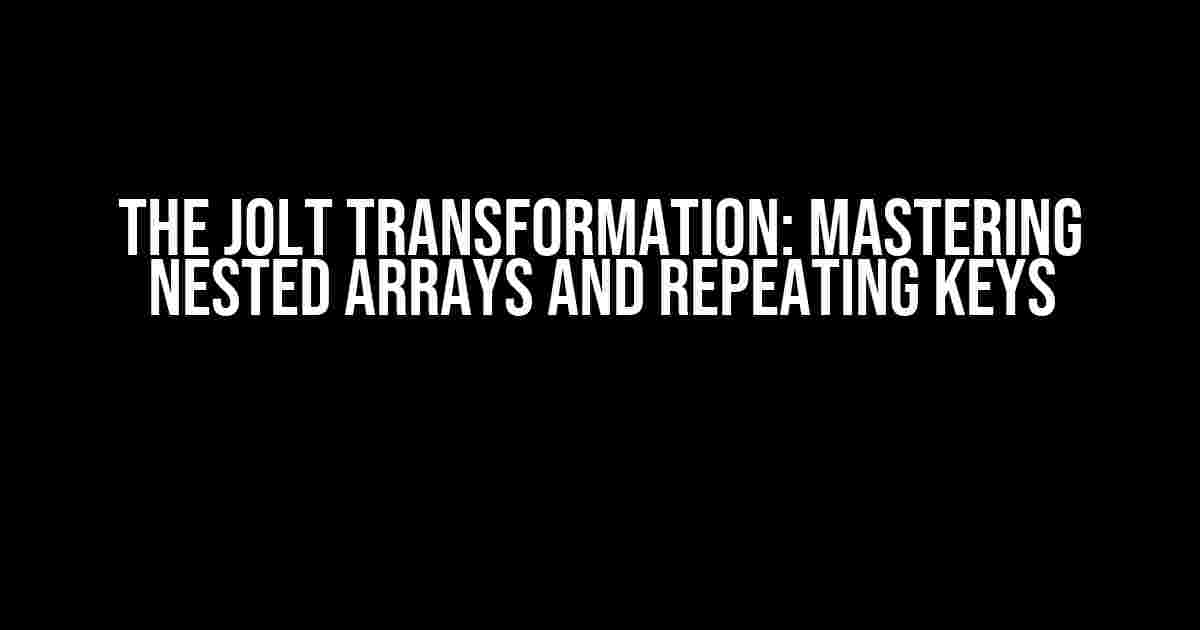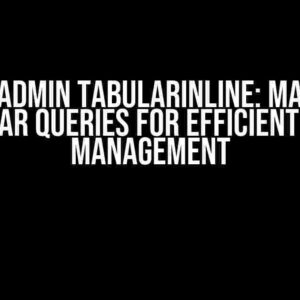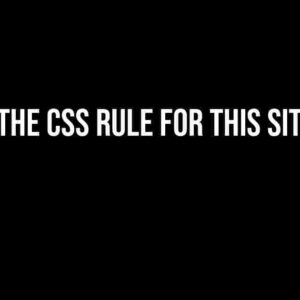Are you tired of dealing with messy and complex data structures? Do you find yourself struggling to make sense of nested arrays and repeating keys? Fear not, dear developer, for we have a solution for you! Introducing the JOLT transformation, a powerful tool that will simplify your data processing and make you a master of data manipulation.
What is the JOLT Transformation?
The JOLT transformation is a data transformation technique that allows you to manipulate and transform JSON data with ease. It is a specification for transforming JSON data between different formats, making it a game-changer for data integration and processing. With JOLT, you can effortlessly handle complex data structures, including nested arrays and repeating keys.
Why Do I Need the JOLT Transformation?
In today’s data-driven world, dealing with complex data structures is a reality. Whether you’re working with APIs, databases, or files, you’ll inevitably encounter nested arrays and repeating keys. Without a powerful tool like JOLT, you’ll be stuck with tedious and error-prone manual data processing. With JOLT, you can:
- Simplify complex data structures
- Eliminate data inconsistencies
- Improve data quality
- Boost data processing efficiency
- Enhance data integration and analysis
How to Use the JOLT Transformation
Using the JOLT transformation is straightforward. Here’s a step-by-step guide to get you started:
Step 1: Define Your Spec
The first step is to define your JOLT spec, which is a JSON object that describes the transformation you want to apply to your data. The spec consists of three main components:
{
"operation": "shift",
"spec": {
"": {
" nested-array*": {
"repeating-key": "&"
}
}
}
}
In this example, we’re using the `shift` operation to transform our data. The `spec` object defines the transformation rules, where `*` indicates a nested array and `&` represents a repeating key.
Step 2: Apply the Transformation
Once you have your spec, you can apply it to your data using a JOLT processor. There are many libraries and tools available that support JOLT, including Java, Python, and Node.js. Here’s an example using the Java library:
import com.bazaarvoice.jolt.JsonUtils;
import com.bazaarvoice.jolt.core.Transform;
public class JoltExample {
public static void main(String[] args) {
String json = "[{ \"nested-array\": [{ \"repeating-key\": \"value1\" }, { \"repeating-key\": \"value2\" }] }]";
String spec = "{ \"operation\": \"shift\", \"spec\": { \"\": { \" nested-array*\": { \"repeating-key\": \"&\" } } }";
Transform transform = JsonUtils.fromJson/spec/spec);
String transformedJson = transform.transform(json);
System.out.println(transformedJson);
}
}
In this example, we’re using the Java library to apply the transformation to our JSON data. The resulting output will be a transformed JSON string.
Step 3: Verify Your Results
The final step is to verify that your data has been transformed correctly. You can do this by inspecting the output JSON string or using a tool like `jq` to parse and analyze the data.
$ echo $transformedJson | jq .
[
{
"nested-array": {
"repeating-key": "value1",
"repeating-key": "value2"
}
}
]
In this example, we’re using `jq` to parse the transformed JSON string and verify that the data has been correctly transformed.
Common Use Cases for the JOLT Transformation
The JOLT transformation is a versatile tool that can be applied to a wide range of data processing scenarios. Here are some common use cases:
Data Integration
Use JOLT to integrate data from different sources, such as APIs, databases, or files. By transforming data into a consistent format, you can ensure seamless integration and analysis.
Data Migration
When migrating data from one system to another, JOLT can help you transform the data into the required format, reducing the risk of data loss or corruption.
Data Quality
Use JOLT to cleanse and transform data to improve its quality. By eliminating inconsistencies and errors, you can ensure that your data is accurate and reliable.
Data Analysis
JOLT can be used to prepare data for analysis by transforming it into a format that’s easy to work with. This enables you to gain valuable insights and make informed decisions.
Frequently Asked Questions
We’ve compiled a list of frequently asked questions to help you get started with the JOLT transformation:
| Q | A |
|---|---|
| What is the JOLT transformation? | A data transformation technique for manipulating JSON data. |
| What is a JOLT spec? | A JSON object that defines the transformation rules. |
| How do I apply the JOLT transformation? | Use a JOLT processor, such as a Java library or Node.js module. |
| What are the benefits of using JOLT? | Simplifies complex data structures, eliminates data inconsistencies, improves data quality, and boosts data processing efficiency. |
Conclusion
The JOLT transformation is a powerful tool for mastering nested arrays and repeating keys. By following the steps outlined in this article, you can simplify complex data structures, improve data quality, and boost data processing efficiency. With JOLT, you’ll be able to tackle even the most challenging data processing tasks with ease. So why wait? Start transforming your data today and unlock the full potential of your data!
Remember, the JOLT transformation is not just a tool – it’s a game-changer. Master it, and you’ll be the master of your data!
Frequently Asked Questions
Get ready to turbocharge your data transformation with JOLT! Here are some burning questions and answers to get you started with nesting arrays and repeating keys like a pro!
Q1: What is the purpose of JOLT transformation in data processing?
JOLT (JSON to JSON) transformation is a powerful tool that helps you transform, reshape, and manipulate JSON data to fit your specific needs. It’s like a Swiss Army knife for data processing, allowing you to handle complex data structures, merge data from multiple sources, and more!
Q2: How do I handle nested arrays in JOLT transformation?
Handling nested arrays in JOLT is a breeze! You can use the “array” specification to iterate over the array elements and apply transformations recursively. Simply specify the path to the nested array, and JOLT will take care of the rest. Easy peasy!
Q3: What happens when I have repeating keys in my JSON data?
No problem! JOLT can handle repeating keys with ease. You can use the “overwrite” or “append” spec to control how JOLT handles duplicate keys. Want to merge values or replace them? JOLT’s got you covered!
Q4: Can I use JOLT transformation to transform data from multiple sources?
Absolutely! JOLT is designed to handle complex data transformations, including data from multiple sources. You can merge data from different APIs, files, or even databases using JOLT’s powerful transformation capabilities. The possibilities are endless!
Q5: Are there any best practices for writing JOLT transformation scripts?
Yes, indeed! When writing JOLT transformation scripts, it’s essential to keep your specs organized, use comments to explain your logic, and test your transformations incrementally. Also, don’t be afraid to break down complex transformations into smaller, manageable chunks. Happy transforming!







